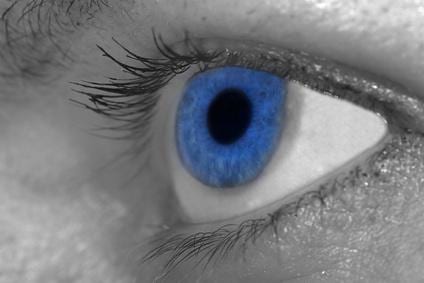With human eye color, it is possible for you to have blue eyes when your mom has brown. The variation in color from parent to child often leaves a person wondering how the body determines eye color. New parents may be curious to know the potential odds of their baby developing one color over another.
History
Prior to 2010, most scientists believed one gene determined your eye color. This belief led scientists to credit a recessive/dominant pattern as the deciding factor in what a person’s eye color would be. Further research changed this belief.
Factors
Melanin is a product of cells in the human body, according to the National Institutes of Health. It produces color, or pigment, in the body, resulting in the color of your skin, hair and eyes. Light blue eyes have the least amount of melanin, and dark brown or black eyes have the most, reports the Science Education Partnerships.
Along with melanin, your genetic makeup plays a role in the color of your eyes. Iris color goes beyond the three basic categories of blue, green and brown, reports a study conducted by the Manfred Kayser of the Erasmus University Medical Center in Rotterdam, The Netherlands. The university’s study identified three genes, including the LYST gene, responsible for an estimated 50 percent of variance in eye color. The Science Education Partnerships website identifies additional genes. Two reside on chromosome pair 15, and chromosome pair 19 hosts another one. These genes have allele pairs, such as the brown and blue alleles on the bey 2 gene of chromosome pair 15, which help determine your eye color.
Time Frame
The amount of melanin present in human eye color at the time of birth varies according to race and genetics, reports the What to Expect website. In Hispanic, African-American and Asian babies, there is usually enough melanin present to cause dark brown or black irises. In Caucasian babies, it can take up to three years before the eyes have enough pigment to change from blue to brown. In most cases, a baby’s eye color will begin to change between six and nine months of age.
Types
While eyes have more variance than three simple categories, most forms of eye color identification use the categories of blue, green and brown. Eyes lacking melanin result in pink or red irises, also known as albino eyes, says Dr. Ron Baker, doctor of science. The lack of pigment allows the color of the blood to show through the irises, resulting in the color.
Considerations
In 10 to 15 percent of Caucasians, eye color can change because of age or illness, reports the Wonder Quest website. Age may reduce the level of pigment in the iris.
Photo Credit
- blue color eye image by Alexander Potapov from Fotolia.com





